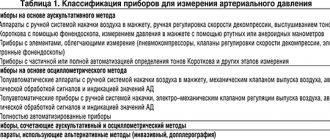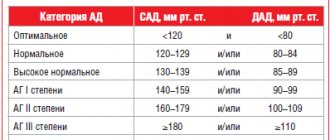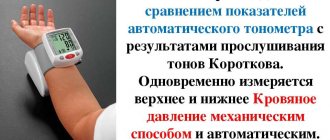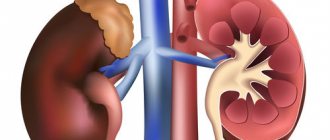Advantages of the Korotkoff method for blood pressure monitoring
Download Slideshow
Author: Tikhonenko V. M.
PDF file
For a hundred years now, the acoustic method of measuring blood pressure (BP), proposed by our compatriot N.S. Korotkov, has been the only officially approved method for non-invasive determination of blood pressure. The Korotkoff method, which we all constantly use in everyday practice, certainly does not need any protection. However, in recent years, opinions have increasingly begun to be expressed that when monitoring blood pressure, this method can be dispensed with. Almost half of the monitors produced for 24-hour blood pressure monitoring (ABPM) no longer use the acoustic method, making measurements using oscillometry. In this work, therefore, we tried to understand the advantages and limitations of both methods.
The most obvious advantage of the oscillometric method is the absence of a microphone - only the application of a cuff is sufficient for measurement, whereas to obtain a result using the Korotkoff method, the microphone must be correctly applied and not dislocated during the observation period. This is an important advantage when self-monitoring blood pressure by the patient, since the likelihood of the patient placing the microphone incorrectly is very high, which will lead to the impossibility of measuring or obtaining incorrect numbers. For example, if the microphone is not pressed against the artery by the cuff, the amplitude of the tones will be very low and the measurement will be unsuccessful. If the microphone is located under the upper part of the cuff, then a sharp increase in systolic blood pressure is possible due to the “tapping” of the pulse wave, even with the cuff compressed (Fig. 1).
With professional testing, such as blood pressure monitoring, when the installation is performed by specially trained medical personnel, the significance of this advantage is negated. An experienced nurse or doctor correctly positions the microphone, and the possibility of its dislocation relative to the artery is eliminated by a separate installation from the cuff - “gluing” it to the skin.
The next frequently mentioned “disadvantage” of the Korotkoff method is the widespread prevalence of individual tonal characteristics, which can result in incorrect blood pressure numbers. For example, with an “acoustic” failure, when the tones in the second phase are very low-amplitude and cannot be heard, systolic blood pressure may be underestimated. With the so-called “endless” Korotkoff sound, when sound phenomena in the vessel continue until very low pressure in the cuff, there is a high probability of underestimation of diastolic blood pressure (Fig. 2). In general, certain features of tones can be observed in 5-7% of patients, complicating the use of the method.
However, in our opinion, the fact that the individual characteristics of Korotkoff sounds are well known to doctors is more an advantage than a disadvantage of the method. Doctors are able to assess blood pressure in patients with special needs. For example, with an “endless” tone, an experienced doctor will usually determine diastolic blood pressure not by the fifth, but by the fourth phase of the tones - when they are sharply muffled. With oscillometry, special variants of pulsations also occur, but we do not know them well and do not know how to eliminate them. An example is the often observed “double-humped bell,” when the pulsation amplitude does not change monotonically, and an underestimation of systolic or overestimation of diastolic blood pressure is possible (Fig. 3). In our experience, certain features of the oscillogram are observed in every tenth patient, but, unfortunately, doctors do not know what can be done to avoid receiving incorrect blood pressure numbers in these cases.
Another limitation of the Korotkoff method is sensitivity to noise in the surrounding space. When there is pronounced noise, such as happens, for example, in a metro train, Korotkoff sounds “drown” in it and reliable measurement of blood pressure is impossible (Fig. 4). This property limits the use of the method for examining, for example, pilots, but in clinical practice this drawback is not significant - usually no more than 1-2% of measurements are rejected based on the presence of noise on the microphone. In addition, the significance of external noise is reduced when differential microphones are used.
The most significant limitation of the acoustic method for blood pressure monitoring is the presence of patients with muffled tones, when the tones are not audible or there is no confidence that all phases of the tones are audible. In such patients, blood pressure is either not determined using the Korotkoff method, or errors are possible - underestimation of systolic and overestimation of diastolic blood pressure. The number of such patients in the population when listening while awake at rest ranges from 2 to 5%. When monitored, this percentage may increase to 5-10% due to a decrease in amplitude during sleep at night. A decrease in the sonority of tones during sleep is observed in all patients, and in some of them it may be critical in terms of the accuracy of blood pressure measurements. Oscillometry has clear advantages here - such low-amplitude pulsations, from which it is impossible to reliably determine blood pressure, occur with a frequency of no more than 0.1% only in cases of severe obesity.
On the other hand, the oscillometric method also has disadvantages. When measured at rest, according to most studies, its accuracy is slightly lower than that of Korotkov. For example, when assigning a class according to the BHS90 or BHS93 protocol, Korotkoff monitors usually correspond to class A/A, while oscillometric monitors are often classified as B/A. This is understandable, since the “reference” blood pressure is usually taken to be the pressure measured by two experts using the Korotkov method. This drawback is not so significant, since devices are being improved and the accuracy of measuring blood pressure at rest is constantly increasing.
Much more significant is the low noise immunity of blood pressure measurements using the oscillometric method during the patient’s physical activity. With minimal movements of the arm, which occur even during quiet walking, pronounced fluctuations in pressure in the cuff occur, which mask the pulsations of the artery and make it impossible to measure by oscillometry (Fig. 5). As a result, when using only the oscillometric method, complete immobility of the patient during the measurement is necessary - otherwise the measurement will be rejected. During the daytime, during patient activity, measurements rejected by pressure pulsations predominate, while measurements by Korotkoff sounds are possible in most of these cases.
Thus, according to our data, when examining 60 patients while climbing stairs, it was possible to correctly measure blood pressure using the Korotkov method in 85% of cases, while the oscillometric method was able to determine blood pressure in only 8.3% of patients (p<0.05). According to A.N. Rogoza (1996), it was possible to successfully measure blood pressure during bicycle ergometry in 93% of cases when using the Korotkov method and in only 18% when using oscillometry. Thus, the oscillometric method does not allow assessing blood pressure during the patient’s free behavior. When using only this method, the diagnostic value of ABPM is significantly reduced, since the doctor sees only changes in pressure at rest, which is enough to detect nocturnal hypertension or “white coat syndrome”, but is clearly not enough to characterize the entire daily blood pressure profile. The features of the oscillometric and Korotkoff methods of measuring blood pressure during monitoring are summarized in table. 1.
Having considered the advantages and limitations of both methods, we can conclude that for ABPM monitors should be used that provide measurement using two methods. In patients with sonorous Korotkoff sounds, they will allow you to measure blood pressure during the patient’s activity and obtain a minimum number of defective measurements carried out with high accuracy using the acoustic method. In cases of muffled tones or when measuring in conditions of pronounced external noise, the device will measure blood pressure using an alternative oscillometric method and blood pressure figures will nevertheless be obtained. In measurements where there is no pressure interference and there are sonorous tones, a combination of the two methods, if the results match, will give the doctor additional confidence in the accuracy of the measurement.
General information about blood pressure and how to measure it
Why know your blood pressure?
Increase in pressure for every 10 mm Hg. increases the risk of developing cardiovascular diseases by 30%. People with high blood pressure are 7 times more likely to develop cerebrovascular accidents (stroke), 4 times more likely to develop coronary heart disease, and 2 times more likely to develop vascular damage to the legs. It is by measuring blood pressure that it is necessary to begin the search for the cause of such frequent manifestations of discomfort as headache, weakness, and dizziness. In many cases, blood pressure requires constant monitoring, and measurements should be taken several times a day.
What methods are used to measure blood pressure?
There are 2 methods currently widely used to measure blood pressure:
Korotkoff method
This method, developed by the Russian surgeon N. S. Korotkov in 1905, uses a very simple device for measuring blood pressure, consisting of a mechanical pressure gauge, a cuff with a bulb and a phonendoscope. The method is based on complete compression of the brachial artery with a cuff and listening to sounds while slowly releasing air from the cuff.
Advantages:
— recognized as the official standard for non-invasive blood pressure measurement for diagnostic purposes and for verification of automatic blood pressure meters;
- high resistance to hand movements.
Flaws:
- depends on the individual characteristics of the person making the measurements (good vision, hearing, coordination of the “hands-vision-hearing” system);
— sensitive to noise in the room, the accuracy of the location of the phonendoscope head relative to the artery;
— requires direct contact of the cuff and microphone head with the patient’s skin;
- technically complex (increases the likelihood of erroneous indicators during measurement) and requires special training.
Oscillometric method
This is a method that uses electronic devices. It is based on the device recording air pressure pulsations that occur in the cuff as blood passes through a compressed section of the artery.
Advantages:
— does not depend on the individual characteristics of the person making the measurement (good vision, hearing, coordination of the “hands-vision-hearing” system);
— resistance to noise loads;
- allows you to determine blood pressure with a pronounced “auscultatory failure”, “endless tone”, weak Korotkoff sounds;
— allows you to take measurements without loss of accuracy through thin clothing fabric;
- does not require special training.
Flaw:
— when measuring, the hand must be motionless.
What devices are used to measure blood pressure?
Mechanical (aneroid) and electronic meters are currently used to measure blood pressure.
Mechanical meters based on the Korotkoff method are mainly used in professional medicine, because Without special training, errors in indicators are allowed.
Semi-automatic and automatic electronic devices are most suitable for home use. Their use does not require any prior training and, subject to simple guidelines, allows you to obtain accurate blood pressure data by pressing one button.









